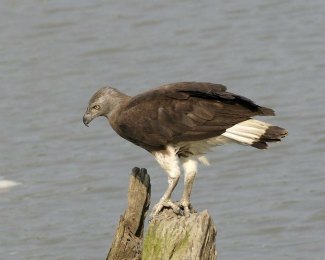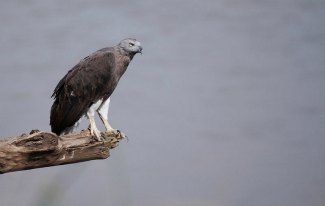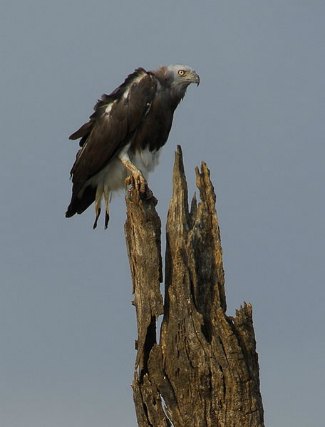Grey-Headed Fish Eagle - Ichthyophaga ichthyaetus
By Lip Kee, CC-BY-SA-2.0, via Wikimedia Commons
Family: Accipitridae
Genus: Ichthyophaga
Species: I. ichthyaetus
Grey-Headed Fish Eagles are medium-sized, brown and gray eagles that live in India and Southeast Asia, overlapping the range of its relative Ichthyophaga humilis (Lesser Fish Eagle).
Physical Description:
Grey-Headed Fish Eagles are brown-gray from above and white below, and—true to their name—the head is gray. The tail is white with a black terminal band and the undertail is the same, while underwing coverts are gray-brown. The head is small, though they have a long neck, and the tail is rounded. The short legs are unfeathered and gray, and the talons are long and black. Eyes are yellow-brown, and the cere is gray-brown to black.
Ichthyophaga ichthyaetus is sometimes mistaken for Ichthyophaga humilis (Lesser Fish Eagle), but the latter has no white on the tail and is lighter in color.
Juveniles are brown along the head and neck with buff and white markings, and the secondary feathers are faintly barred. The tail is white and mottled, the breast is brown, the flanks are streaked with white, and the belly and thighs have brown markings.
Their calls are loud "awh awhr" and "chee warr" repeated 5-6 times, in addition to owl-like "oo wooks". They are also known to scream. Listen to a Grey-Headed Fish Eagle.
Size:
Length: 61-75 cm
Wingspan: Male: 42-45.5 cm. Female: 44.5-51.8 cm.
Weight: Male: 1.6 kg. Female: 2.3-2.7 kg.
By Brian Gratwicke, CC-BY-2.0, via Wikimedia Commons
Habitat and Distribution:
They live in lowland forest up to 1,525 meters above sea level, close to large bodies of water such as lakes, marshes, swamps, lagoons, reservoirs, and slow-moving rivers and streams, along with estuaries and coastlines. Their alternative English name in Sri Lanka, the "Tank Eagle", comes from their being found near irrigation tanks.
Grey-Headed Fish Eagles occur from India to southeast Asia, the Philippines, and Sulawesi, from 38°N to 6°S. There are approximately 1,000-10,000 individuals. Adults are sedentary, but juveniles disperse from breeding areas.
Diet and Hunting:
As their name would suggest, their diet is primarily fish. However, they also eat other prey, such as reptiles.
When hunting fish, they hunt from a perch and snatch their prey from the surface of the water, something for which their curved talons are specialized. If the fish is too big to carry, they will drag it ashore.
Reproduction:
The breeding season is from November-May across most of their mainland range, though it starts in December in Sri Lanka, April in Sumatra, and August in Borneo. During that period they become noisy, often calling at night.
The nest is built out of sticks and lined with green leaves, and placed 10-30 meters above the ground in a tree close to water. Nests are usually used for years in a row and can grow to be 1.5 m wide and 2 m deep. 2-4, usually 2, unmarked white eggs are laid and incubated by both parents for 45-50 days. Fledging takes 70 days.
Public domain, via Wikimedia Commons
Conservation:
The population is declining due to loss of wetland habitat, over-fishing, human disturbance, and pollution. Ichthyophaga ichthyaetus is currently listed as Near Threatened by BirdLife International.
Proposed conservation actions include conducting surveys to determine important areas for the birds, regular monitoring at sites across the eagles' range, and protecting forest habitat.
Taxonomy:
Grey-Headed Fish Eagles are closely related to sea eagles belonging to the genus Haliaeetus.
Subspecies:
The Sri Lankan population is sometimes recognized as I. i. plumbeiceps, but not by some authorities; due to lack of consensus, it is not considered a separate race here.
Other Names:
Ceylon Grey-Headed Fishing Eagle, Grey-Headed Fishing Eagle, Greater Fishing Eagle, Tank Eagle, Flodørn (Danish), Grote Rivierarend (Dutch), Suur-jõogikotkas (Estonian), Isokalakotka (Finnish), Pygargue à tête grise (French), Graukopf-Seeadler (German), Elang laut kelabu (Indonesian), Aquila pescatrice testagrigia (Italian), Uokiwashi (Japanese), Helang Kanguk Besar (Malay), Båndelveørn (Norwegian), Rybozer bialosterny (Polish), Pigarguillo Común (Spanish), Gråhövdad fiskörn (Swedish).
Video of a Grey-Headed Fish Eagle:
References:
http://www.arkive.org/grey-headed-fish-eagle/ichthyophaga-ichthyaetus/
http://avibase.bsc-eoc.org/species.jsp?avibaseid=4C0573904094D55B
BirdLife International (2011) Species factsheet: Ichthyophaga ichthyaetus. Downloaded from http://www.birdlife.org on
11/12/2011.
Global Raptor Information Network. 2011. Species account: Grey-headed Fish Eagle Ichthyophaga ichthyaetus. Downloaded from
http://www.globalraptors.org on 11 Dec. 2011
BirdLife International 2008. Ichthyophaga ichthyaetus. In: IUCN 2011. IUCN Red List of Threatened Species. Version 2011.2.
www.iucnredlist.org. Downloaded on 11 December 2011.
Ferguson-Lees, James, and Christie, David A. Raptors of the World. Houghton Mifflin Company, 2001.


